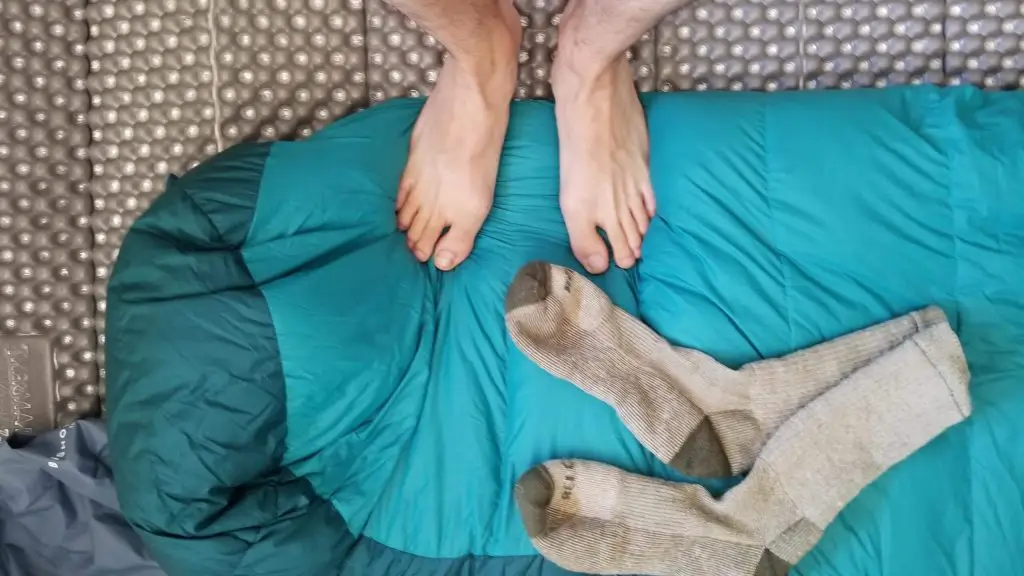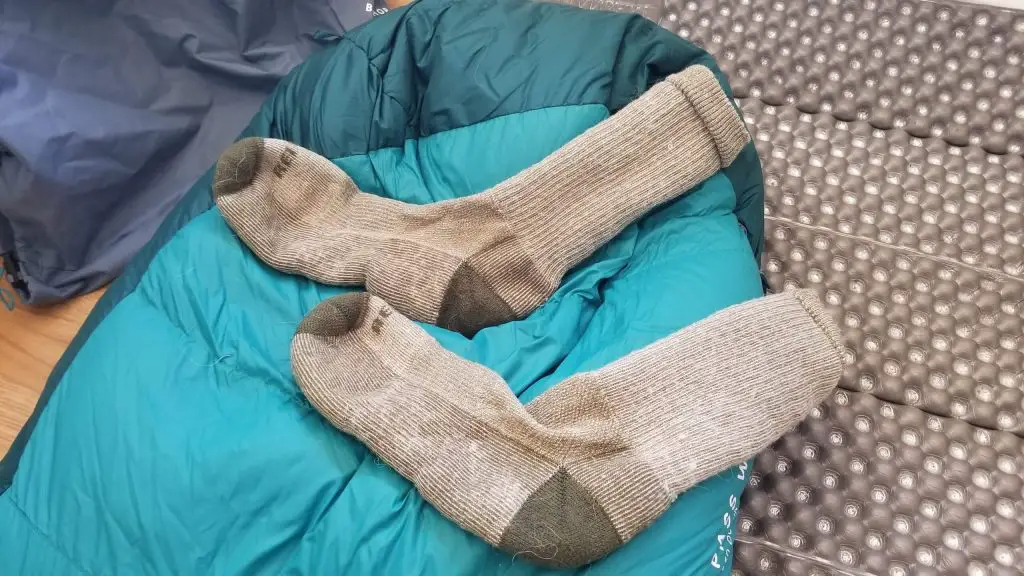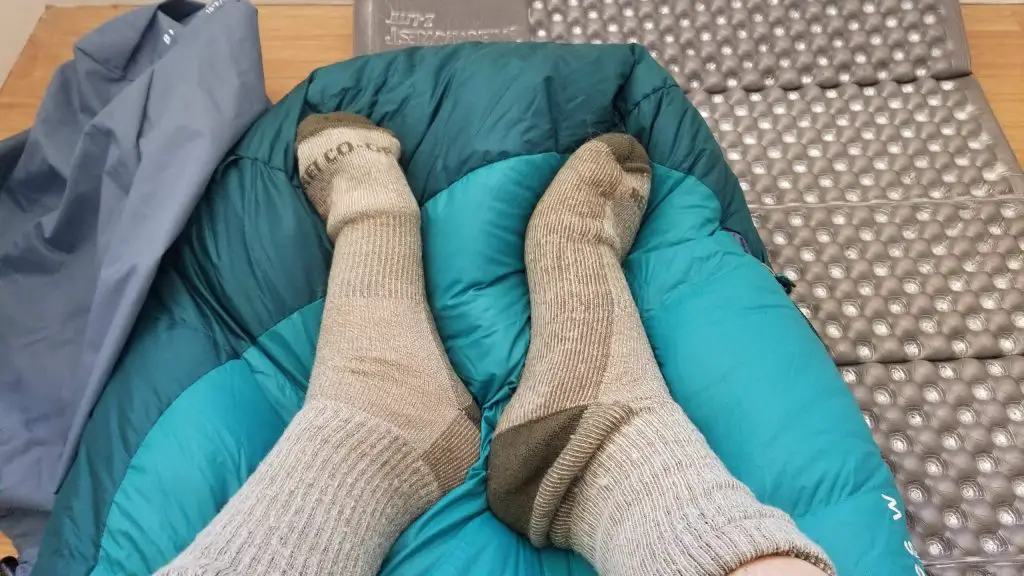You bought a down sleeping bag with a low degree rating and you have the prefect sleeping pad, yet your feet still feel cold when you’re bundled up in your sleeping bag. Having cold feet while trying to sleep in your tent can keep you up all night, so what can you do to warm up your feet inside your sleeping bag?
The best ways to warm your feet in your sleeping bag are to wear fresh thick wool socks, add a warm bottle of water near your feet, or use heating pads.
I used to go camping and lay wide awake wondering why my feet are freezing cold. It wasn’t until I saw posts online suggesting I switch to wool socks and use external heat sources that I was able to finally have warm feet and sleep soundly. While these solutions will help you have warm feet in your sleeping bag, there are a number of other things you should setup so that you have an optimal tent and sleeping setup. Doing these things will help you have a warmer tent and will lead you to warmer feet, which in turn will help you fall asleep much more easily.
Keeping Your Feet Warm While In A Sleeping Bag

Picking the Best Tent Location
Before you start adding things to your sleeping bag to warm your feet, you could potentially be draining all of the heat and warmth from out of your tent before you even lay down. Picking the right spot for your tent will make a huge difference of whether the inside of your tent is cold or warm. When setting up your tent you want to setup near a wall or giant boulder. If those are not available then find a spot near a bush or another tent.
If you are in an open area then face your tent parallel with the wind flow so that wind blows in the same direction of your tent. Setting up your tent in a non-windy area or with the flow of wind is crucial to having a warm tent. Your tent location is the base of how warm or cold you will feel in your sleeping bag.
Covering Your Tent
After choosing the best tent location, the next thing you can do is cover your tent with the rain cover. Having the rain cover over your tent will block any potential wind from entering and also help trap the heat inside the tent. Having this extra layer will help your feet be much warmer inside your sleeping bag.
Even after you have a rain cover and have chosen a good spot, there are small pockets where cold drafts can still flow in. You can block these areas with your pack or rain jacket. This will make a huge difference in feeling warm or cold since cold air won’t be blowing on your feet or face as you try to sleep.
Picking the Right Direction to Face
If the ground is flat and you notice cold air still entering then the last thing to decide is which direction you should have your head and where your feet will go. There have been times where I have camped and the cold air only blew at my feet which made them feel extra cold at night. You can determine which side gets the draft that will help you sleep best.
With a good tent location, rain cover to trap warm air, and a direction to lay down chosen, now we will go over the smaller things that can help warm your feet in your sleeping bag.
What to Wear to Keep Your Feet Warm In Your Sleeping Bag

Your Sleeping Bag
The first thing that will make a huge difference in the warmth of your feet is having the right sleeping bag. Be sure to get a sleeping bag that is rated for the time and season you are camping. If you sleep cold, you should get a sleeping bag that is 10 to 15 degrees lower than the expected temperatures. My partner uses a 15 degree bag even in the summer months because she doesn’t generate enough body heat and feels cold at night.
Once you have a warm enough sleeping bag then you should notice a big difference in how warm or cold you feel. The downside to sleeping bags is that the down can move around over time. Make sure your down is fluffed up and evenly distributed in the feet are to help warm your feet as you sleep.
The Right Socks
One of the first things you should do when you get to camp is to take off your dirty hiking socks. Give your feet some time to breathe and then change to a fresh new pair of socks. The moisture from the sweat of your feet will make your feet will much colder.
However, before you swap socks make sure that you have the right socks to begin with. For hiking you should get a pair of merino wool socks. These help wick moisture away, are breathable, offer enough padding for hiking, and are warm enough on cold nights. Having wool socks will make a huge difference over common cotton socks.
Darn Tough Wool Socks on Amazon
Your Sleeping Pad
While this isn’t inside of your sleeping bag it make a big difference. Make sure your sleeping pad is long enough so your head and feet are on it. If your feet are hanging off your sleeping pad then you will feel the cold from the ground. Any heat generated from your feet will be drained from the cold floor.
Something else to look into for your sleeping pad is the heat rating. There are sleeping pads that at thicker and provide better insulation. Check to make sure your sleeping pad insulation rating is sufficient for the time you are going camping.
Highest Rated Amazon Sleeping Pad – Therm-a-rest NeoAir
Sleeping Bag Liner
You have the right sleeping bag, a big and thick enough sleeping pad, and you have wool socks, but your feet still feel a bit cold. The last gear item you can use to help add warmth to your feet is a sleeping bag liner. A sleeping bag liner is like a mini sleeping bag that goes inside your sleeping bag. It will help add about 5 to 8 degrees of warmth to your feet.
Sleeping bag liners also help keep your sleeping bag clean since your sweat and body oils will go on the liner instead of the sleeping bag. This will help keep your feet warm and extend the life of your sleeping bag since you won’t have to wash the sleeping bag.
Highest Rated Sleeping Bag Liner on Amazon – Teton Sports Liner
Other Ways to Keep Your Feet Warm In A Sleeping Bag

Warm Bottle
After all of the above things are done and you still have cold feet then there are a few more things you can do to warm your feet even more. The first option is to heat up water and put it into a heat-resistant water bottle. This external source of heat will emit heat throughout the night and help your feet feel warm during the night. You can have multiple bottles to warm different parts of your body if one isn’t enough.
The downside to using a warm bottle is you have to carry an extra bottle and you have to use water to boil. If the weather is extra cold then the warm bottle can get cold relatively quickly, so this won’t work as well in the freezing cold winter months, but its better than nothing.
Heat Resistant Nalgene Bottle on Amazon
Heat Pads
Another option of an external heat source is to use heating pads. You can use Hot Hands heating pads. These are easy and convenient to use. You just peel the pouch and they will warm up. They are rated to last around eight to ten hours. The great thing about them are they are small and can be placed in many different areas. The downside of them is they produce a lot of trash and waste since they are only one time use.
Hot Hands 10 Hour Heating Pads on Amazon
Double Socks
The last line of defense in gear to warm your feet in your sleeping bag are to double up on your socks. For the coldest nights this is a great option. You can wear two thick socks. This will block external wind and cold from getting to your feet. If it is extra windy then I cover my feet with my rain pants to block any additional cold drafts.
Final Thoughts
Turning from side to side and laying wide awake in your sleeping bag due to cold feet is a recipe for a restless night. I used to lay wide awake wondering why my feet were so cold in my sleeping bag. It wasn’t until my friends recommended some solutions and things I learned over the years helped me warm my feet in the tent.
Picking the right tent setup, covering your tent, and laying in the right area will ensure you have a warmer tent. Once you have an optimal tent setup then its down to having a warm enough sleeping pad, long enough sleeping pad, and a good pair of wool socks. Now you have a great baseline to start with and can use warm bottles or heating pads to supplement missing heat and warm your feet within your sleeping pad. Enjoy your next camping trip with warm and cozy feet!
